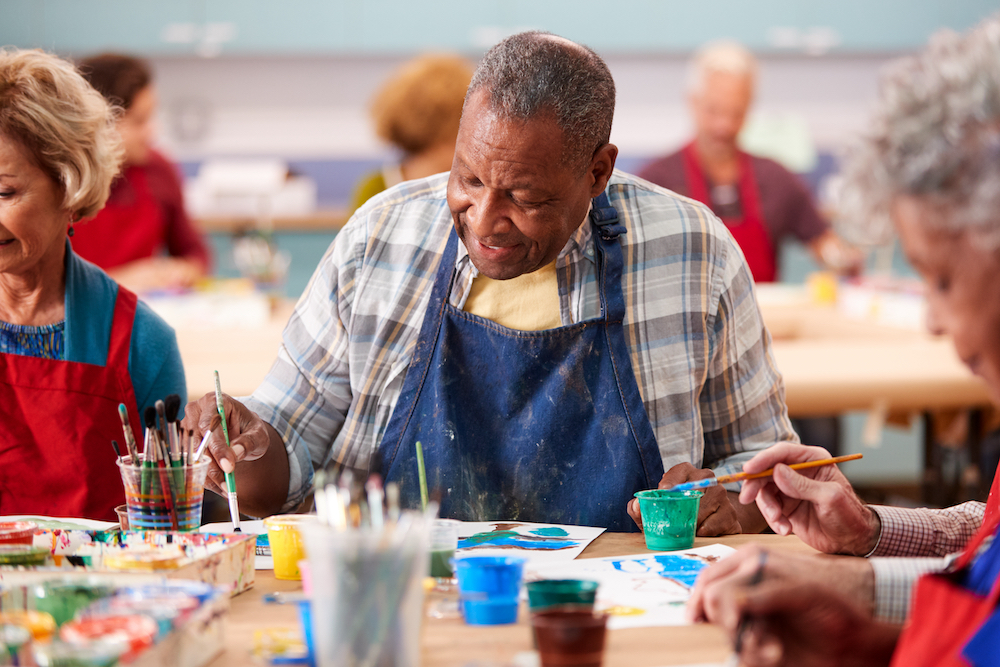Being creative has a whole host of benefits for the mind and body. So unsurprisingly, art is a great activity for the older adults living in assisted living homes.
After all, art is a creative process. It involves creating something from nothing. This process helps provide the mind more stimulation and promotes feelings of wellbeing. Therefore, art becomes an irreplaceable activity for many people to function at their best.
The benefits of art therapy don’t stop there. There are many more, especially for the elderly. There’s a good reason why so many assisted living homes and caregivers invest in art therapy. There are even trained art therapists who specialize in this role.
Here we’ll be taking a look at the specific benefits of art therapy for seniors. You’ll see why we promote art therapy in our assisted living homes and how you can get started as an individual or caregiver.
Improves Cognition
There is a mounting amount of scientific evidence that art therapy improves brain functioning as well as increases intellectual stimulation. Art therapy has also worked well as a palliative care method for individuals with Alzheimer’s or dementia.
When you give someone the task of creating a work of art, you’re asking them to come at things from a different angle, a different perspective. This in itself stimulates the mind and increases cognitive abilities over time.
As a matter of fact, for seniors who have suffered memory loss, art therapy can help them to remember memories thought long lost. Additionally, learning new forms of art enhances thinking skills and the ways in which seniors form neural connections. These abilities decline as we age, but art therapy can help to slow down this natural decline.
Improves Motor Skills
Art therapy may also enhance motor skills. After all, certain forms of art require specific movement and coordination, and repeatedly performing these motions can improve motor functions, especially in seniors.
What happens is that over time, when the arms and hands are used more often, blood flow and muscle coordination are improved drastically. They will be able to experience a wider range of movements and experience greater physical dexterity.
Pain Relief
These greater capabilities from the benefit above will allow seniors to experience reduced pain and inflammation, leading to pain relief. This is important because lots of seniors experience chronic pain issues. Hypertension, inflammation, and arthritis are common culprits. Since art therapy is normally a relaxing activity, it may help to lower stiffness in the hands as well as inflammation.
Additionally, being focused on just one task can help them forget about any aches or pains they may be experiencing.
That’s not to say that the pain won’t still be there. But we are saying that not focusing on it for a short time can be very beneficial.
And some seniors may find that this technique will even lower the inflammation that led to the pain in the first place. The reason why is that the small and precise movements involved in art therapy can enhance blood flow while seniors are using their arms, hands, and fingers.
In short, art therapy may not solve chronic pain, but it can help a lot in managing their pain discomfort. Also, there are good arguments out there that art therapy is good at boosting our immune system.
Stress Relief
Art helps us to maintain a good emotional balance, and for seniors, this helps them manage stress and reduce anxiety.
Art therapy for seniors in assisted living homes should be focused on the creative process. This means that they should be focused on expressing their emotions and feelings. When a senior does that, they will be allowed to release their inner turmoil and lower their stress as a result.
For instance, art therapy is frequently used with dementia and Alzheimer’s patients. Memory loss is, unfortunately, a very stressful circumstance for both seniors and caregivers. So, art therapy can help in these situations to create happiness and feelings of calm. Thus, it’s an excellent way to alleviate stress in seniors and their caregivers.
Lowers Depression
According to a study published in the Social Work in Health Care Journal, seniors living in a care home were able to show that art helped relieve their depression and boost their self-esteem.
As this study shows, art therapy can benefit a senior’s overall mental wellbeing. The authors of the study commented that art therapy could enhance long-term care and move it in a “more diverse, unique, and innovative direction.”
A prominent way that art fights depression Is the effect it has on our bodies. Making art encourages the release of dopamine, known as the “happy” chemical. Therefore, it makes perfect sense why art therapy is so good at fighting depression.
A Safe Social Activity
Lots of art therapy programs, especially in assisted living homes, are conducted in social settings. It can also be seen as an alternative method of socializing with people, and it allows seniors an extra opportunity to form connections with others.
It helps enable relationship building with fellow adults as well as their caregivers and helps mitigate feelings of social isolation. With COVID-19, these benefits are even more important. And finally, since art can be done as an individual activity, it’s easier to adhere to physical distancing guidelines in a social setting.
Makes Communication Easier
Art can be an excellent activity for seniors who have more difficulty communicating. In that case, it can be the perfect means of self-expression. And if done in a social setting, they will learn how to better connect with others as well as with themselves. And it provides similar benefits that socializing does – reducing negative feelings of isolation and loneliness.
In short, art therapy is an amazing way for seniors to connect with everyone close to them, including friends, loved ones, and caregivers. This is especially true if they are affected by memory loss or other issues that make communicating more difficult.

